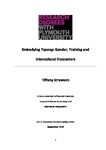Embodying Topeng: Gender, Training and Intercultural Encounters
| dc.contributor.supervisor | Ladron de Guevara, Victor | |
| dc.contributor.author | Strawson, Tiffany | |
| dc.contributor.other | Faculty of Arts, Humanities and Business | en_US |
| dc.date.accessioned | 2016-12-22T16:39:06Z | |
| dc.date.issued | 2016 | |
| dc.identifier | 10319911 | en_US |
| dc.identifier.uri | http://hdl.handle.net/10026.1/8168 | |
| dc.description | Appendix 1 and 2 have been published and permissions have been granted by University of Hawai'i Press. | en_US |
| dc.description.abstract |
This research centres on the Balinese performance tradition known as topeng which translates as Balinese masked dance-drama. In Bali this genre is performed traditionally in spaces reserved for religious ceremonies. The research questions the extent to which, and how, it may be possible for a non-Balinese person to embody a culturally coded, sacred object (the mask) and how a woman is able to make meaning and express herself within a genre which is traditionally the preserve of men. The research has therefore sought to develop an individual and intercultural approach to both the design of new masks and their performance. The thesis critiques modes of cultural understanding in relation to notions of balance, based on colonial and dualistic trajectories between Bali and the UK. Alternative modes of exchange explore in-between and hybrid space that is informed by Lo and Gilbert’s dynamic model of intercultural practice which they visualise as a ‘spinning disc held by an elastic band’ (Gilbert and Lo 2002: 45). The key issues explored are notions of training; the relocation of ritual and the cultural specificities of ‘home’; mask-making and design; non-Balinese stories on which to base alternative performances of topeng, ones that more strongly position female characters; and finally the embodiment of Balinese masks from a traditional and also a somatic perspective. The practical form the research takes is through making masks and devising performances, the outcomes of which form a part of the thesis. The thesis both discusses and practically demonstrates how particular modes of embodiment, for instance cakra work, somatics and experiential anatomy may serve as strategies to communicate to a Western perspective how to bring ‘life’ to the mask, how to make it ‘work’ from a Balinese position and how these modes can assist in the process of intercultural (self) translation. | en_US |
| dc.language.iso | en | |
| dc.publisher | University of Plymouth | |
| dc.rights | CC0 1.0 Universal | * |
| dc.rights.uri | http://creativecommons.org/publicdomain/zero/1.0/ | * |
| dc.subject | Bali | en_US |
| dc.subject | Intercultural | |
| dc.subject | Masks | |
| dc.subject | Training | |
| dc.subject | Ritual Performance | |
| dc.subject | Topeng | |
| dc.subject | Dance, Masked | |
| dc.subject.classification | PhD | en_US |
| dc.title | Embodying Topeng: Gender, Training and Intercultural Encounters | en_US |
| dc.type | Thesis | |
| plymouth.version | publishable | en_US |
| dc.identifier.doi | http://dx.doi.org/10.24382/1088 | |
| dc.rights.embargodate | 2017-06-22T16:39:06Z | |
| dc.rights.embargoperiod | 6 months | en_US |
| dc.type.qualification | Doctorate | en_US |
| rioxxterms.funder | Not available | en_US |
| rioxxterms.identifier.project | Not available | en_US |
| rioxxterms.version | NA |
Files in this item
This item appears in the following Collection(s)
-
01 Research Theses Main Collection
Research Theses Main



